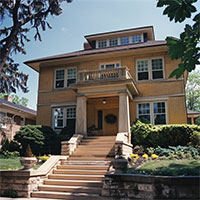What is a physician mortgage loan?
Physician loans let eligible medical professionals purchase a home with attractive rates and terms

The average new doctor leaves school with approximately $200,000 in medical school debt, according to data from the American Medical Association (AMA). Meanwhile, in 2022, the average dentist graduated with $293,900 in dental school debt, per data from the American Student Dental Association (ASDA).
Crushing student debt can put medical professionals in a precarious position when it comes to buying a home after graduation. After all, financial institutions that offer mortgages typically require applicants to meet specific requirements, including a minimum credit score, down payment amount and a maximum debt-to-income (DTI) ratio.
This is where physician mortgage loans, or "doctor loans," come into play. Mortgage lenders that offer these loans recognize the unique financial position new doctors and dentists are in once they graduate from school and accept a new position, as well as their future earning potential. As a result, doctor loans have a much lower barrier to entry than some other types of home loans.
Physician mortgage loans are easier to get approved for than other types of home loans since lenders recognize the future income potential of eligible medical professionals.
Jump to insightThese loans often come with low down payment requirements or no down payment required, no mortgage insurance and higher thresholds for debt.
Jump to insightDoctor loans can work for certain eligible medical professionals, including most practicing doctors and dentists.
Jump to insightHow do physician mortgage loans work?
Mortgage industry veteran Casey Fleming, author of “Buying and Financing Your New Home,” says physician mortgage loans are mostly geared toward doctors just out of residency who haven't had enough time to establish salary history or save up a substantial down payment. These loans let eligible borrowers purchase a home right after they graduate school and finish their residencies without having to meet the strict requirements of other types of home loans.
In fact, doctor loans may come with:
- No down payment requirement
- No private mortgage insurance (PMI)
- Higher thresholds for debt (to accommodate for medical or dental school debt)
- Less stringent employment requirements (a job offer may suffice)
These home loans for eligible medical professionals are typically for primary residences only, and may be offered in amounts up to $1 million with zero money down. For larger home loans of $1.5 million or $2 million, applicants may need a down payment of 5% to 10%, depending on the lender.
» MORE: How to choose a mortgage lender
Physician loan borrower’s qualifications
The type of medical professionals that can qualify for a physician loan can vary from lender to lender. However, these loans are often available for doctors and dentists who have the following credentials:
- Doctor of Dental Medicine (D.M.D.)
- Doctor of Dental Surgery (D.D.S.)
- Doctor of Osteopathic Medicine (D.O.)
- Doctor of Podiatric Medicine (D.P.M.)
- Doctor of Science (D.S.)
- Doctor of Veterinary Medicine (D.V.M.)
- Medical Doctor (M.D.)
Existing doctors and dentists who are already working in their field are eligible for these loans. For those who aren't working yet, Fleming pointed out that borrowers may need to have completed a residency and accepted a position related to their degree and specialty before they can qualify. Some lenders also offer physician loans to eligible medical professionals who are currently in residency or completing fellowship training.
Credit score requirements are often higher for physician loans than for conventional home loans. In fact, borrowers may need a credit score of 660 or higher depending on the lender.
Property qualifications
Physician loan uses are fairly broad, although the borrower must be purchasing a home to use as a primary residence. Loan limits can also apply and cap how much medical professionals can spend on a property. For example, some lenders only offer physician loans in amounts up to $1 million with no money down. Others may loan up to $2 million for a home with a down payment of 10% or more.
Pros and cons of physician mortgage loans
Physician mortgage loans let medical professionals purchase a property they wouldn't otherwise qualify for. They do this by basing approvals on future income potential instead of how much they're earning today.
That said, these loans still come with their share of advantages and disadvantages:
Pros of doctor loans
- Potential for a low down payment or no down payment
- Higher debt-to-income (DTI) ratios accepted to accommodate student debt
- No private mortgage insurance (PMI) required
- Less stringent employment requirements (an official job offer may be enough)
Cons of doctor loans
- Higher interest rates than other types of home loans
- Interest rates are typically variable
- Physician loans are only for a primary residence
- $0 down payment loans have a higher risk of becoming an underwater mortgage
Physician mortgage alternatives
If you're considering a physician loan but you're not sure if it's the best option, consider these alternatives.
Conventional mortgage
If you are already working as a medical professional and you have a minimum credit score of 620, you may be able to qualify for a conventional mortgage. These loans require private mortgage insurance (PMI) if you put down less than 20%, but interest rates are typically lower than you'll find with physician loans.
You can also have PMI removed from the home loan when the amount you owe is scheduled to fall to 80% of the original value of your home.
One downside of this type of mortgage for medical professionals is maximum debt-to-income (DTI) requirements. Conventional mortgages often require applicants to have a DTI of 45% or less, which can be a problem for new doctors and dentists with substantial student debt.
FHA home loan
FHA home loans let borrowers put down as little as 3.5% with a credit score as low as 580, and they come with competitive interest rates. Debt-to-income (DTI) requirements may also be more flexible than you find with conventional mortgages.
However, FHA loan limits set a cap on borrowing that may not work for medical professionals who want to purchase an expensive property.
In 2024, FHA loan limits are set at $498,257 across most of the U.S. and $1,149,825 in certain areas with a high cost of living
VA loan
Medical professionals who are active duty military members or veterans can also consider VA home loans. These loans come with flexible credit requirements and the option to put down $0, as well as competitive interest rates. VA loans also come without a requirement for mortgage insurance, although a VA funding fee must be paid at closing.
» LEARN: How does a mortgage work?
FAQ
How does a physician mortgage loan differ from a conventional loan?
Physician loans offer more lenient requirements for doctors and other medical professionals. For example, they allow higher levels of debt (specifically student loan debt) and the potential for a $0 down payment. These loans also come without any requirements for private mortgage insurance (PMI).
Can you refinance a physician loan?
You can definitely refinance a physician loan in the future. Doing so can make sense if you qualify for a lower interest rate or better loan terms later on.
Are physician loans usually fixed or variable?
Most physician loans are adjustable-rate mortgages (ARMs), although it may be possible to lock in a fixed rate. Make sure to check with the best mortgage lenders for today's interest rates and loan terms.
Bottom line
Physician loans make it possible for eligible medical professionals to purchase a home sooner with terms that are suitable for their future financial picture. For example, doctors and dentists may be able to use a job offer to get funding of up to $1 million for a home with no money down and no requirement for PMI.
However, because these loans are typically offered as adjustable-rate mortgages (ARMs) and tend to come with higher interest rates, they may not be ideal for the long term. Fortunately, it's possible to refinance physician loans in the future to lock in a lower rate or better loan terms.
Article sources
- American Student Dental Association, "Dental Student Debt." Accessed March 25, 2024.
- American Medical Association, "Say goodbye to physician residency—and medical student-loan debt?' Accessed March 25, 2024.
- Association of American Medical Colleges, "OCTOBER 2023 Medical Student Education: Debt, Costs, and Loan Repayment Fact Card for the Class of 2023." Accessed March 25, 2024.
- Truist, "Doctor mortgage loans." Accessed March 25, 2024.
- Fifth Third Bank, "Physician Mortgage Loans." Accessed March 25, 2024.
- Physician Bank, "PHYSICIAN LOANS – 42 BEST ANSWERS FOR PHYSICIANS." Accessed March 25, 2024.
- Consumer Financial Protection Bureau, "When can I remove private mortgage insurance (PMI) from my loan?" Accessed March 25, 2024.
- U.S. Department of Housing and Urban Development, "Let FHA Loans Help You." Accessed March 25, 2024.
- U.S. Department of Housing and Urban Development, "Maximum Mortgage Limits 2024." Accessed March 25, 2024.
- U.S. Department of Veterans Affairs, "VA Home Loans." Accessed March 25, 2024.
- United Community Bank, "Physician Mortgage Loan." Accessed March 25, 2024.
